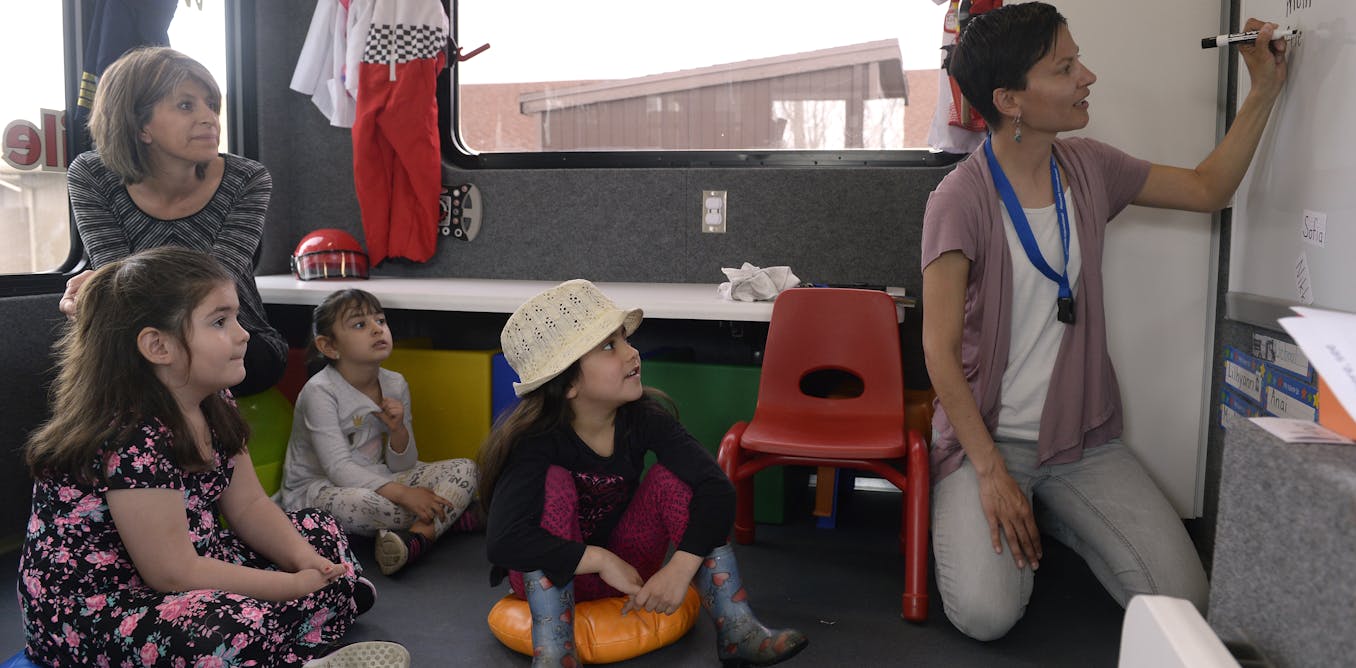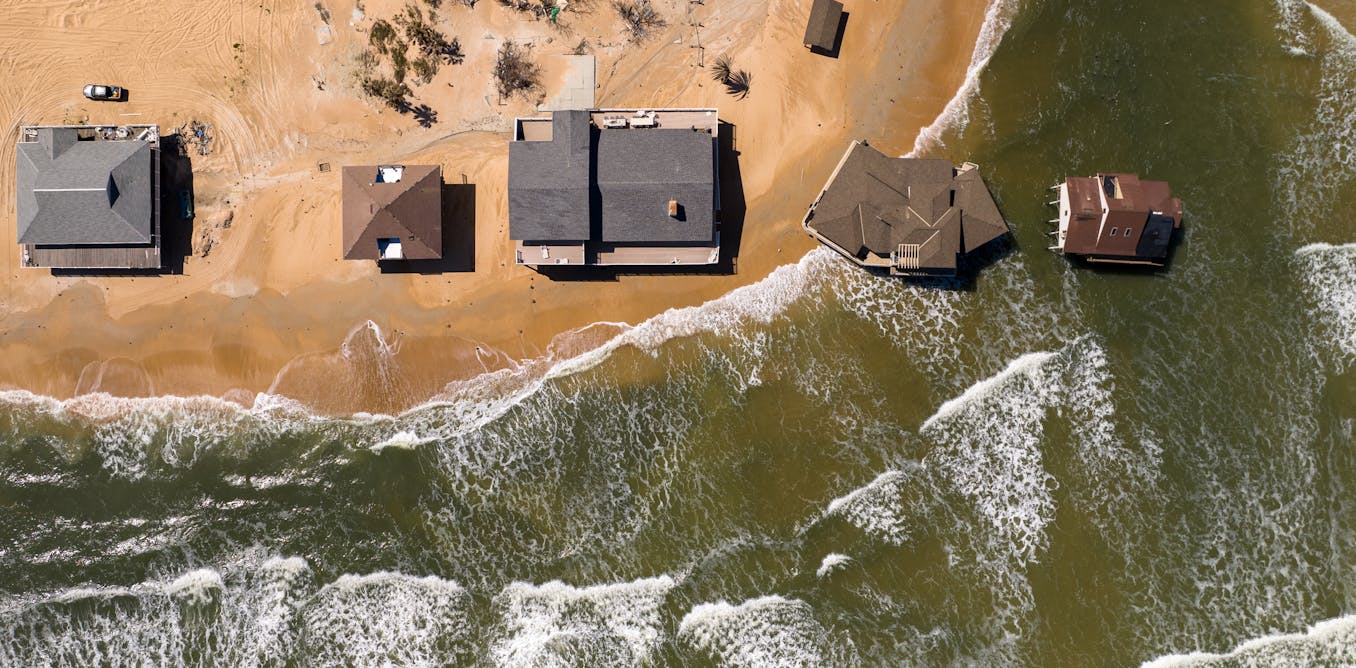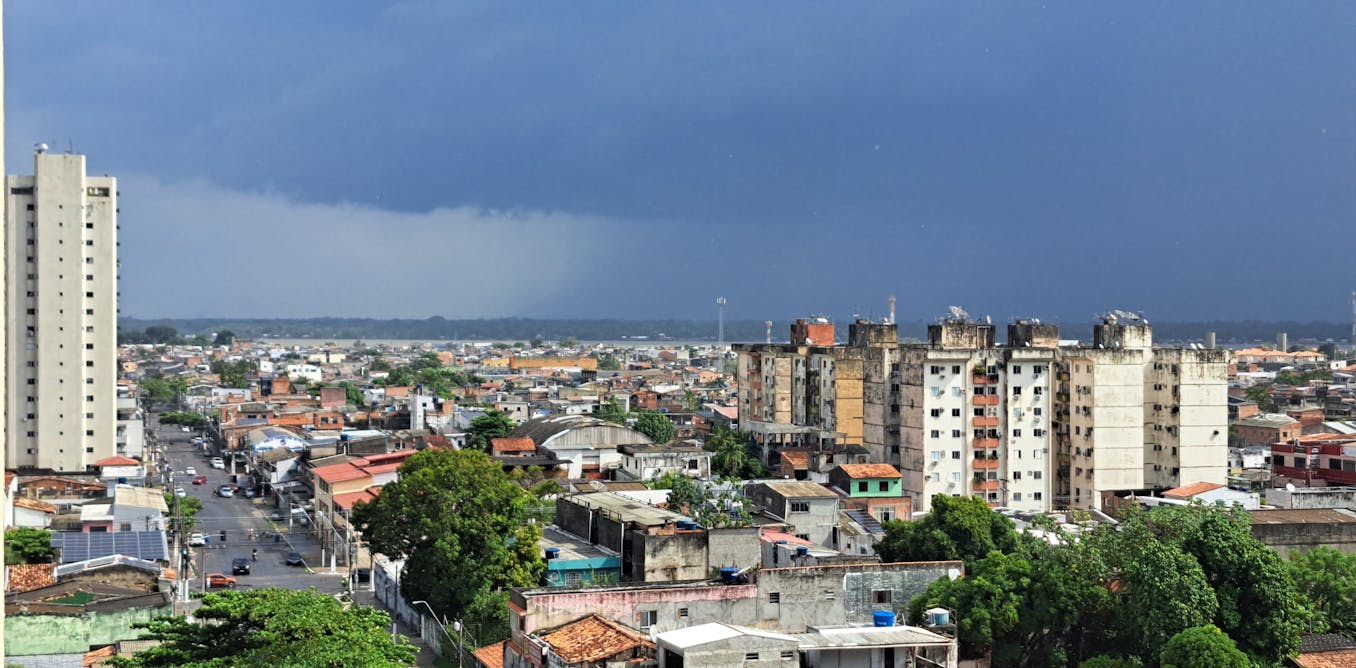ON FRIDAY, SEPTEMBER 27, torrential rainfall from Hurricane Helene caused the French Broad River in Asheville, North Carolina, to crest at 24.67 feet, the Swannanoa tributary at 26.1. All that water flowed outward from the banks and sloshed into surrounding neighborhoods, obliterating most everything in its path. Systems and infrastructure across the city were knocked out: power lines, cell towers, water distribution systems, and ATMs. While early fatality reports were low, it was apparent that the death toll would balloon in the coming days of no power, no water, no promise of returning to normal. Officials warned that downed trees and debris blocked countless narrow and winding mountain roads, isolating people in their homes. Routine travel, where possible, became arduous—though there was hardly anywhere to go.
Helene missed me in Winston-Salem, and for the first few hours of Friday morning, we thought it had missed my partner, Basil, on Asheville’s east side, as well. But as time went on, his texts became more sporadic, more urgent. Some were sent from Mission Hospital, where he’d go for a bottle or two of water (drinking water would not be restored until November 18, 53 days after the storm hit). He sent others from the sidewalk in front of a boutique downtown hotel that surprisingly still had working Wi-Fi, and with it, a connection to the outside world. I was brainstorming evacuation plans, but gas stations were closed for miles, and he had only a quarter of a tank left. We heard that all the interstates and major thoroughfares were closed, and soon, I’d see footage of a whole section of I-26 falling away, snapping off the side of the mountain like a block from a chocolate bar.
Growing up in upstate South Carolina and living in the far western part of North Carolina for the past few years—in a sliver of the state eerily spared Helene’s wrath—these places were all familiar to me, either as the homes of friends and craftspeople, beloved spots for family vacations, or historically important areas that continue to foster robust, thriving communities. Seeing all the destruction was initially incomprehensible. Amid it all, my mind turned to artists. Age-old art and craft practices are woven into the fabric of western North Carolina’s culture, and of the wider Appalachian region too. What would the storm chisel away from this core piece of regional identity?
By Sunday morning, a section of I-26 East had reopened, allowing Basil to take a roundabout route to reach me. As he was leaving Asheville, news of Helene’s destruction was finally getting out through mainstream outlets. Aerial photographs and videos of the River Arts District—a neighborhood Helene’s waters almost completely swallowed—proliferated on our social feeds. Images of a few roofs protruding from a sea of murky brown water sent our minds spinning, trying to predict what was safe and what would be left.

“IT’S SO STRANGE to be in the epicenter of a disaster and not know what’s happening,” Tracey Morgan, who has operated an eponymous gallery in Asheville since 2017, told me over the phone. “I could get a cell signal in a certain place, but I couldn’t get any data. [My husband and I] didn’t see any news. We had no idea of anything unless we saw it firsthand.”
Fortunately, her gallery space suffered only minimal damage and was restored with a few days of mopping, airing out, and scraping up floor paint. But just across the parking lot, the water was two feet higher. And just two miles down the road, where one of Morgan’s artists, painter Hannah Cole, has her studio, the story was completely different. Cole lost everything when the Swannanoa overflowed, ravaging and washing away much of the Southside Studios building. “My studio is on the river side of the building, so as the waters receded, it drained out through my studio, leaving a two-foot layer of mud, now layered in mold,” she wrote on Instagram. “My entire flat file,” she lamented, “every sketchbook, every experimental and unfinished piece, every drawing was inside.”

Tucked into a commercial district between the now devastated Biltmore Village and the still standing Asheville Mall, which transformed into a hub for recovery efforts, Southside Studios is an 8,000-square-foot warehouse that started renting to artists in 2013. Neighbors include a propane supplier, a scrap metal dealer, an appliance repair shop, and a mix of repurposed and revitalized depots, including a punk-inspired antique mall, a 4-year-old brewery, and a CrossFit studio. It’s an ideal area for resourceful creatives, as forgotten warehouse districts with lower rent often are. Being parallel to the Swannanoa River was a risk that artists like Cole and potter Melissa Weiss were willing to take.
“We’ve had flood scares before,” Weiss told me, “but even when it flooded a good amount—like once, we rode a canoe down our street to get to the studio—water was still about five feet from getting into the building.” Weiss produces her stoneware using clay that she digs from a plot of land she owns in the Ozarks of Northwest Arkansas, and her pieces are crafted without a pottery wheel. She lost supplies almost irreplaceable, and pieces time-intensive and one-of-a-kind.

By the time Weiss and I spoke a couple weeks later, she was taking stock of the damage and trying to figure out the best way forward. All the studio’s electric kilns were gone. Her team saved two gas kilns, but one was filled with so much mud that “we couldn’t open it.” East Fork, the trailblazing Asheville-based ceramic dinnerware company cofounded and co-owned by Henri Matisse’s great-grandson, offered to help Weiss move her kilns and store them temporarily. Help came in via GoFundMe donations, offers of teaching engagements, and emergency residency opportunities. Still, rebuilding will be a significant hurdle. “It’s this catch-22,” she told me. “We have to rebuild so we can make a living, but we can’t rebuild the studio unless we can make a living.”
Weiss coped by putting it all into perspective, remembering that “in this area, people have lost their entire homes, their lives, or even their loved ones.” Still, “I know more artists who have lost their studios than not.” And when overwhelmed, she realized it helps to “think about it in little pieces” or one step at a time. “People who grew up in Louisiana sent me letters and talked about how they lost everything [during Katrina]—they watched their elementary school wash away, things like that—and they wrote, ‘you’ll get through this. We did.’”
THE RIVER ARTS DISTRICT, a mile-long stretch of 26 studio buildings and material suppliers along the French Broad River, was home to more than 300 artists and supply warehouses in repurposed buildings that welcome thousands of visitors yearly. Gaining a reputation in the mid-1980s as a hub of cheap, spacious, industrial workspaces, River Arts has transformed into a multifaceted complex and fashionable tourist destination. Some of the buildings—and even former artist studios—have been converted into restaurants, bars, and a record store. To complement an artsy afternoon, the City of Asheville developed a sprawling greenway along the riverbank, with attractive landscaping, branded sculptures, and public restrooms to boot.

Basil and I drove into the District a week after the flood. Most of the water had receded, and much of the neighborhood was reduced to rubble. We pulled up to Riverview Station, a tannery-turned-studio building that had survived the notorious hundred-year flood of 1916; it was structurally sound, but the insides were destroyed. Hunks of drywall and mud-splattered artwork were laid out across the parking lot to dry. One artist had lined their works up opposite the building, leaning on the guardrails parallel to the French Broad River. “These paintings have a water line from the second floor,” read a folded cardboard sign next to the works, advertising them for sale at half price. “They will clean up easily with foaming cleanser on the surface.”
I couldn’t fault their entrepreneurial endeavor. Gawking has been a defining feature of western North Carolina tourism, especially from September to November. In the autumn months, we call them “leaf peepers,” folks coming from across the country to see the changing, fiery-colored foliage from the comfort of the passenger seat. Peeping happens primarily on the Blue Ridge Parkway, a New Deal–era, car-centric effort initially billed as the Appalachian Scenic Highway, with plenty of turnouts to admire how red, orange, and yellow treetops fade into hazy blue and violet peaks.
This fall, leaf peeping turned into disaster peeping. As the afternoon wore on, more and more cars descended on the River Arts District, driving slowly and rubbernecking along Lyman Street, the neighborhood’s main thoroughfare. Even in tragedy, River Arts was made into a spectacle, an attraction. It was easy to understand how a survivalist impulse to capitalize followed.
On the studio side, volunteers, who had to sign a liability waiver from the landlord and often bring their own PPE, shoveled out sludge in the hope of clearing out the building before mold set in. If meteorologists’ numbers and viral videos were hard to believe, the exterior walls of Riverview offered physical proof: darkened bricks up to the lower third of the second floor led to a wavy line, showing how high the waters had risen.
ABOUT 24 MILES north of Asheville, along the banks of the French Broad River, sits downtown Marshall—a two-lane Main Street that’s idyllic on most days, but that resembled a war zone when we visited more than two weeks after the storm. To streamline recovery efforts, the town had effectively closed the central road; Basil and I had to park at the supersize grocery store off the highway and ride with a local volunteer to Nanostead, a sustainable tiny home builder that has become a de facto mutual aid hub. From there, we moved from tent to tent—signing in, suiting up with donated PPE, hopping into the bed of a flatbed truck—before reaching downtown to meet potter Alexandra Barao.

Cleanup was still the top priority. Almost everyone wore hazmat suits, snug respirators, and, sometimes, army gear as they pressure washed the mud from buildings, cleared out ruined storefronts, and distributed supplies. As a tanker truck rumbled by spraying water on the road, Barao explained, “they’ve been wetting the streets to try to keep the dust down,” a reminder of the unknown toxins likely among the debris.
The three of us crossed the half-mile bridge from downtown to Blannahassett Island, where the old Marshall High School now houses more than two dozen artist studios and an event space. We met Frank Lombardo, a painter who has had a studio at Marshall High for 15 years and is now leading the cleanup effort. He described having to climb through a window to get into the building, since the door locks had been jammed with mud. By the time we visited, the muck was gone, but the floorboards were warped and white shelves were stained brown. In the event space, bundles of starch-white paper lanterns, untouched by the rising waters, hung from the high ceiling, swaying slightly in the breeze from the open windows.
Lombardo expressed gratitude for the help from volunteers and the United States Army, but admitted that all the attention was overwhelming. “I’m an introverted painter,” he said, his voice hoarse from having shouted over power washers for days on end. “Now, I’m managing 50 soldiers and 40 volunteers. I don’t know how to do this.” He credited friends and other area artists for helping him manage this enormous undertaking, a reminder that rallying support and community devotion is another effect of catastrophes like Helene, one too often overlooked.

“Disaster, along with other moments of social upheaval,” wrote Rebecca Solnit in A Paradise Built in Hell (2009), “is when the shackles of conventional belief and role fall away and the possibilities open up.” In recent years, it seems that artists’ roles are constantly evolving, expanding beyond their traditional boundaries owing to economic insecurity and the devaluation of creative labor, a notion that social practice works and other interventions have played with to mixed results. Here, in the storm’s aftermath, artists inadvertently took on roles as emergency managers, authority figures, mutual aid organizers, town spokespeople, and agents of recovery. It was daunting, but also inspiring to witness a community, however momentarily, value artists as leaders. The determination that was driving rebuilding ignited creativity, joy, ingenuity, and a communal spirit. Temporarily, we set aside tourism, big business, and other capitalist drives that have fueled regional growth for decades.
Josh Copus, a Marshall-based potter, shared this feeling: “I’m fully committed at this point,” he told me as we drove to deliver tools to a friend. Our freewheeling conversation focused on Marshall’s great progress, but also the uncertainty that loomed—especially for Copus, who also owns several businesses in town.
On the Saturday after the storm, he’d found himself asking, “do we have a town here anymore? Before we could get down in here, when you’re just seeing the flooding, it felt like there’s no way we can come back from this.” Then, folks started showing up: cleaning, salvaging, coming together to help one another physically and emotionally. For Josh, it was energizing, a glimmer of hope for a place that felt, in the early hours, condemned. Copus owns the downtown Old Marshall Jail Hotel and Zadie’s Market, along with Clayspace Co-op in Asheville’s River Arts District; the market and hotel had been ravaged. Even still, he said, “this town was never the buildings. It’s always the people who make the place. And we’ve got the best people.”

The post “How Artists Are Rebuilding Asheville After Hurricane Helene” by Emily Watlington was published on 01/22/2025 by www.artnews.com





































Leave a Reply